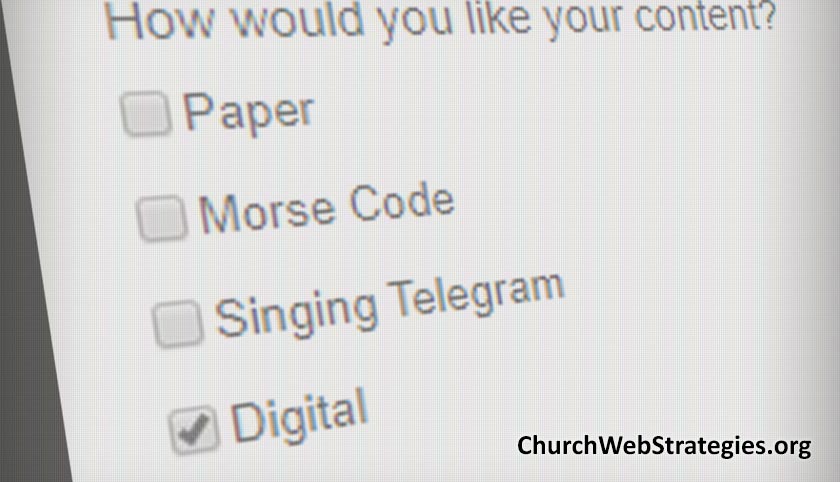The British government has adopted the phrase “digital by default”. This means you start as many projects as possible in a digital space. By considering digital deliverables first, their strengths become more apparent, and their weaknesses can more easily be mitigated. This article delves into how this idea can be applied to your church.
What does a digital by default church look like? I am hoping that it looks like a church that is embracing and integrating technology to further spread the Gospel. This can also mean that you will reduce operating costs by spending less on printed materials. Not to mention the added bonus of being more environmentally conscious. Use a “digital by default” strategy to print less and interact more.
Announcements
By using your website, email subscriptions, social media, and SMS marketing, you can greatly reduce the space required in your weekly bulletins. Do not rely on people to visit your website every week. We are bombarded with digital noise on a daily basis, so you need to come to them, and on a delivery channel they are comfortable with.
Bulletins
Every week your staff creates a bulletin that has announcements of upcoming events, an outline of the sermon, information on daily devotionals, who donated the flowers on the altar, and a myriad of other things. Instead of printing these out to be handed to your congregation, post them to a tablet and smartphone optimized portion of your website. To make it easier to find, post QR codes at key spots in the church that direct them to that Sunday’s bulletin URL.
Digital Prayer Requests
If you and your congregation active on social media, ask for prayer requests in the form of private messages. Solicit prayer requests on your website as well. Do you have times of inflection during your service? Use a mobile-friendly form so congregation members to fill out forms using their tablets and smartphones instead of traditional pen and paper. An even better experience would be to provide a notification that you did indeed pray for them. Even if it is a standard response, it lets them know you followed through on your promise.
Interactive Questionnaires
Want feedback on a particular subject? Why not create a simple questionnaire your congregation can partake in. Unless you absolutely require personal information, accept anonymous submissions. It may seem like a risk, but input on mobile devices via virtual keyboards is often cumbersome and time-consuming.
Music
If you have a church band that puts out its own music, go ahead and link to sites where your congregation can sample, stream, and even purchase those songs. We often wish to recreate those worship moments where we feel closer to God. Offering easy access to that music is one way for them to accomplish this.
Digital by default is a strategic move, and these are just a few tactical solutions. I encourage you not to stop with this short listing of my ideas. There are so many unique and innovative directions a digital by default church can go in. If you have any not mentioned here, please add it to the comments for others to see.
Action Item
In the weeks prior to going digital by default, poll your congregation to see how interested they are in doing this. This will help you gauge how much you can scale back on printed materials. Pray over what makes the most sense to do in light of your church’s culture. Then move to integrate these into a future cycle of updates so your church can use a “digital by default” strategy to print less and interact more.
Note: This article was inspired by Paul Boag‘s article and AudioBoo, Digital by Default.


Good thoughts as usual. I like the idea of digital by default. I’m not convinced (unfortunately) that most churches are ready to replace their announcement sheets with webpages, but even if paper announcements are still necessary, including announcements online shouldn’t be an afterthought.
One thing: by “times of inflection during your service” I assume you mean “times of reflection”?
Thank you again for your continued reading and support. Yes, reflection, inflection, meditation; basically a spot in the service where pastors can ask the congregation to think of a prayer request. By offering digital channels (via a QR code in the physical world, or a link on their website) we can hopefully collect and respond to those requests more easily and efficiently. I also agree that many churches are not ready for this yet. However a long-term strategy can be realized; and some of these ideas can be implemented over the next few years.